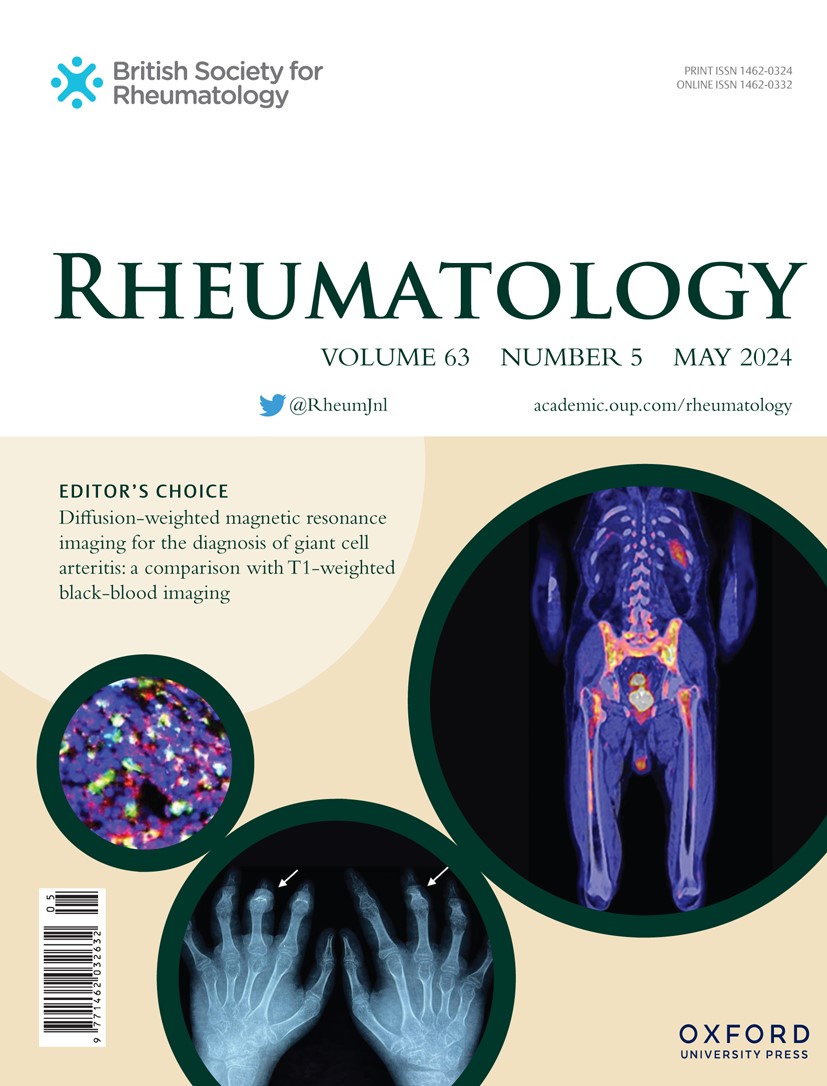非家族性、家族性和单基因狼疮的单中心比较
IF 4.7
2区 医学
Q1 RHEUMATOLOGY
引用次数: 0
摘要
目的:系统性红斑狼疮(SLE)与遗传有关。单基因SLE是SLE的一种独特形式。我们调查了家族性或已知的单基因狼疮病例是否可以通过临床或实验室表型在高亲缘人群中与非家族性狼疮区分开来。患者和方法我们对24个多重家族进行了回顾性病例对照研究,包括62例病例和95例非家族性狼疮对照组。比较两组的人口学和系统性狼疮国际合作诊所的标准。家族性病例也通过全外显子组测序和细胞表型进行评估。使用R Studio进行统计分析。结果家族性红斑狼疮与非家族性红斑狼疮相似,但家族性红斑狼疮发病年龄较轻(18岁vs 26岁,OR = 0.91, p= 1.61x10-5),滑膜炎患病率较高(OR = 2.7, p= 0.013),高水平dsDNA抗体患病率较低(OR = 0.25, p= 1.9x10-3)。外显子组测序的一个子集的诊断率为36%。单基因狼疮与其他家族性病例的区别在于发病年龄更小(6岁vs 19岁,OR = 0.82, p = 2.13 × 10−3),男女比例无偏倚(p = 0.077)和衰竭CD4+ T细胞(CD4+CD45RA+PD-1+)的扩增(p = 1.7 × 10−4)。结论总体而言,临床表型是家族性或单基因狼疮的较差指标。家族性狼疮和单基因家族性狼疮(MoFL)往往比非家族性狼疮出现在更年轻的年龄,表现出较少的女性偏见,在某些情况下,可以通过淋巴细胞特征来区分。血缘关系增加了单基因家族性狼疮的发病率,这些病例可以出现在成年期。本文章由计算机程序翻译,如有差异,请以英文原文为准。
Single-centre comparison of non-familial, familial and monogenic lupus
Objectives There is a significant genetic contribution to systemic lupus erythematosus (SLE). Monogenic SLE is a distinct form of SLE. We investigated whether familial or known monogenic lupus cases are distinguishable from non-familial lupus by clinical or laboratory phenotype in a population with high rates of consanguinity. Patients and methods We performed a retrospective case-control study on 24 multiplex families, comprising 62 cases, and 95 non-familial lupus controls. Demographic and Systemic Lupus International Collaborating Clinics criteria were compared between the two groups. Familial cases were also evaluated by whole exome sequencing and cellular phenotyping. Statistical analysis was performed using R Studio. Results Familial and non-familial lupus cases were similar although familial cases were younger at presentation (18 y vs 26 y, OR = 0.91, p= 1.61x10-5), a higher prevalence of synovitis (OR = 2.7, p= 0.013) and lower prevalence of high level of dsDNA antibodies (OR = 0.25, p= 1.9x10-3). Exome sequencing of a subset yielded a diagnostic rate of 36%. Monogenic lupus were distinguished from other familial cases by an even younger age at presentation (6 y vs 19 y, OR = 0.82, p = 2.13 x10−3), non-biased male to female ratio (p = 0.077) and expansion of exhausted CD4+ T cells (CD4+CD45RA+PD-1+) (p = 1.7x10−4). Conclusion Overall, clinical phenotype is a poor indicator of familial or monogenic lupus. Familial lupus and monogenic familial lupus (MoFL) tend to present at a younger age than the Non-MoFL, exhibit less female bias, and in some cases, are distinguished by a lymphocyte signature. Consanguinity increases the rate of monogenic familial lupus, and these cases can present in adulthood.
求助全文
通过发布文献求助,成功后即可免费获取论文全文。
去求助
来源期刊

Rheumatology
医学-风湿病学
CiteScore
9.40
自引率
7.30%
发文量
1091
审稿时长
2 months
期刊介绍:
Rheumatology strives to support research and discovery by publishing the highest quality original scientific papers with a focus on basic, clinical and translational research. The journal’s subject areas cover a wide range of paediatric and adult rheumatological conditions from an international perspective. It is an official journal of the British Society for Rheumatology, published by Oxford University Press.
Rheumatology publishes original articles, reviews, editorials, guidelines, concise reports, meta-analyses, original case reports, clinical vignettes, letters and matters arising from published material. The journal takes pride in serving the global rheumatology community, with a focus on high societal impact in the form of podcasts, videos and extended social media presence, and utilizing metrics such as Altmetric. Keep up to date by following the journal on Twitter @RheumJnl.
 求助内容:
求助内容: 应助结果提醒方式:
应助结果提醒方式:


